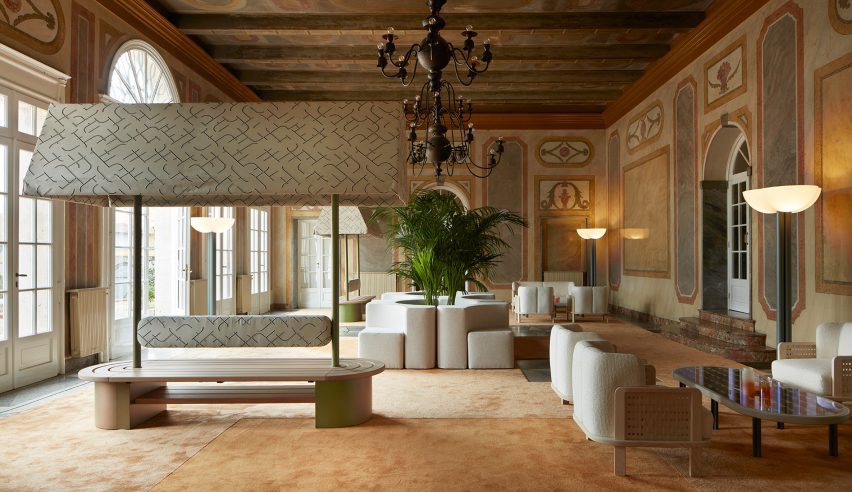Italian architect and designer Cristina Celestino has temporarily refitted a historic Milan tennis club with furniture that references nets, courts and rackets.
For Milan design week, Celestino has taken over the headquarters of the Tennis Club Milano Bonacossa, a building designed by renowned Milanese architect Giovanni Muzio and constructed in 1930.
Her installation, Clay Court Club, sees the building updated with furniture and fittings that feature playful references to tennis.
These include chairs with interwoven details akin to traditional tennis rackets, a bench that takes cues from courtside seating, and carpet that matches the colour of a clay court.
The exhibition marks the fourth time that Milan-based Celestino has staged an exhibition in an "iconic yet hidden" location in the city. As with those before, the installation doesn't prevent the space from functioning as normal.
"I always look for significant but lesser-known places in Milan, as a way to unveil the city to foreigners," the designer told Dezeen.
"My interest is to both establish a relationship with the existing architecture and explore the function of those who use the space."
The works on show are a mix of new designs, custom pieces and existing products.
The most eye-catching piece is the Parasol bench, created under Celestino's own label, Attico Design, in collaboration with local studio Skillmax.
This curved bench features a wooden seat and padded backrest, and is topped by a textile sunshade that Celestino describes as "an oversized hat".
Like many of the works on display, the design combines linear and curved geometries. According to the designer, this is based on Muzio's interest in combining lines with semi-circles in his architecture.
Similar geometries feature on the fabrics, supplied by Italian brand Dedar. Different textiles were selected for indoor and outdoor, riffing on the architectural details of the building.
"We selected durable fabrics with punctual patterns, recalling how the tennis club building is decorated with geometric motives made up of precise graphic signs," Celestino said.
The new Raquette sofa and armchair – a collaboration with Italian brand Billiani – combines woven wooden slats with clean white upholstery, while the Ace table from Attico Design features a metal grid that resembles a net.
Other key pieces include a reinterpretation of a 1960s floor lamp and a modular seating system that frames large tropical plants.
Underfoot, the clay-coloured carpet features precise cutaways that highlight details in the existing floor.
"The new carpet flooring becomes a quotation of the red clay court, emphasising Muzio's rich original marble decorations," said Celestino.
The installation extends to a pop-up restaurant, We Are Ona, located in a circular room in one of the building's two wings.
This space has more of a garden feel, with green carpet, hanging flower arrangements, custom curved tables and green versions of Celestino's Frisée dining chair for Billiani.
It is the only room where the furniture composition is symmetrical. The designer's intention was to respect "Muzio's long yearn for asymmetry" as much as possible.
"Furniture elements are arranged according to an out-of-scale logic, creating a new perspective order that seeks to generate new identities and focus," she said.
Clay Court Club is on show at Viale Romagna 58 in Milan until 23 April 2023. See our Milan design week 2023 guide on Dezeen Events Guide for information about the many other exhibitions, installations and talks taking place throughout the week.

